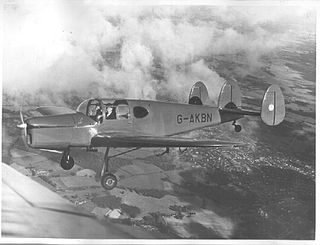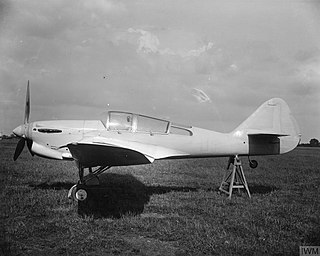
The Miles M.25 Martinet was a target tug aircraft of the Royal Air Force (RAF) and Fleet Air Arm (FAA) that was in service during the Second World War. It was the first British aircraft to be designed specifically for target towing.

The Miles M.9 Master was a British two-seat monoplane advanced trainer designed and built by aviation company Miles Aircraft Ltd. It was inducted in large numbers into both the Royal Air Force (RAF) and Fleet Air Arm (FAA) during the Second World War.

The Miles M.11 Whitney Straight was a 1930s twin-seat cabin monoplane designed and produced by the British aircraft manufacturer Miles Aircraft. It was named after Whitney Straight, a Grand Prix motor racing driver, aviator and businessman. The aircraft was the first to combine a side-by-side seating arrangement with an enclosed cockpit for the general aviation sector.

The de Havilland DH.87 Hornet Moth is a single-engined cabin biplane designed by the de Havilland Aircraft Company in 1934 as a potential replacement for its highly successful de Havilland Tiger Moth trainer. Although its side-by-side two-seat cabin made it closer in configuration to the modern aircraft that military trainee pilots would later fly, there was no interest from the RAF and the aircraft was put into production for private buyers.

The Ikarus Aero 2 was a piston-engined military trainer aircraft built in Yugoslavia in the years following World War II, although the design pre-dated the war.

The Percival Prentice was a basic trainer of the Royal Air Force in the early postwar period. It was a low-wing monoplane with a fixed tailwheel undercarriage. Front seating was in a side-by-side configuration with a rear seat provided.

The Fairey Hendon was a British monoplane, heavy bomber of the Royal Air Force, designed by Fairey Aviation, and first flown in 1930. The aircraft served in small numbers with one squadron of the RAF between 1936 and 1939. It was the first all-metal construction low-wing monoplane to enter service with the RAF.

The Boulton Paul Balliol and Sea Balliol are monoplane advanced trainer aircraft designed and produced by the British aircraft manufacturer Boulton Paul Aircraft. On 17 May 1948, it became the world's first single-engined turboprop aircraft to fly. The Balliol was operated primarily by both the Royal Air Force (RAF) and the Royal Navy Fleet Air Arm (FAA).

The Miles M.38 Messenger is a British four-seat liaison and private owner aircraft built by Miles Aircraft.

The de Havilland DH.94 Moth Minor was a 1930s British two-seat tourer/trainer aircraft built by de Havilland at Hatfield Aerodrome, England. With the start of the second world war production of the Moth Minor was moved to de Havilland Australia at Bankstown Aerodrome, Australia.

The Miles M.16 Mentor was a 1930s British single-engined three-seat monoplane training and communications aircraft built by Miles Aircraft Limited.

The Parnall Heck was a 1930s British four-seat cabin monoplane built by Parnall Aircraft Limited at Yate, Gloucestershire. Originally a Hendy design, few were built. It combined the strength and comfort of a cabin aircraft with the speed of a racer.

The Avro 701 Athena is a British advanced trainer aircraft built by Avro in the late 1940s. It was designed to replace the North American Harvard in the Royal Air Force, but was bought only in small numbers, the competing Boulton Paul Balliol being preferred.

The Miles M.2 Hawk was a twin-seat light monoplane designed and produced by the British aircraft manufacturer Miles Aircraft Limited during the 1930s. It is the first of the company's aircraft to attain quantity production.

The Miles Hawk Major was a 1930s British two-seat light monoplane, developed by Miles Aircraft from the Miles Hawk in order to take advantage of the new inverted de Havilland Gipsy Major engine. When fitted with the longer Gipsy Six in place of the forward crew member, it was known as the Miles Hawk Speed Six.

The Miles Hawk Trainer was a 1930s British two-seat training monoplane designed by Miles Aircraft Limited.

The Miles M.3 Falcon is a 1930s British three/four-seat cabin monoplane aircraft designed by Miles Aircraft Limited.

The Miles M.7 Nighthawk was a 1930s British training and communications monoplane designed by Miles Aircraft Limited.

The Miles M.9 Kestrel was a 1930s British single-engined tandem seat monoplane, intended as an advanced trainer. Only one Kestrel was built but it was developed into the Miles Master for the RAF and produced in large numbers at the start of the Second World War.

The Miles Hawk Speed Six was a 1930s British two-seat light monoplane, developed by Miles Aircraft from the Miles Hawk Major by fitting the longer and more powerful Gipsy Six engine and removing the forward crew member.
























